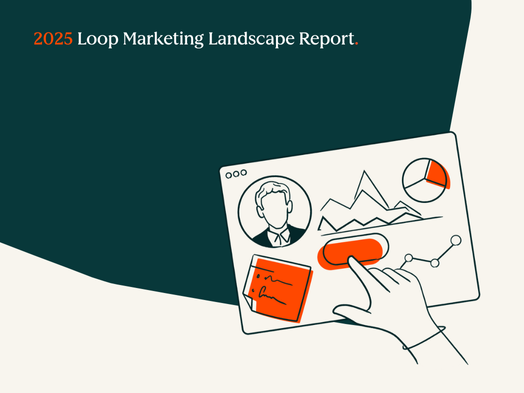Across B2B organizations, next-year planning pressure is familiar: pipeline targets are rising, budgets aren’t, and buyers are more discerning than ever. Add in market uncertainty, and the stakes feel higher than ever. Meanwhile, AI has exploded into the GTM ecosystem with bold promises of speed, precision, personalization, and efficiency. The question is no longer if CMOs should use AI—but whether it will accelerate growth or create new unimaginable risks.
Most CMOs understand that AI can’t build effective strategy alone. The organizations pulling ahead right now are not those who added the most AI tools; they’re the ones who integrate AI into strategic decision-making while still relying on real customer experience, operational discipline, and market insight.
A recent McKinsey study found that companies embedding AI into their GTM programs are 2.5× more likely to outperform peers in revenue growth, and AI-powered ABM efforts deliver up to 25% higher engagement and 30% faster sales cycles. But behind these numbers is a truth no algorithm can replace—effectiveness requires expertise.
AI is a game-changer for GTM planning, but only when anchored in human judgment. Here’s how CMOs should be using it.
Plan Faster—Not Looser
How many of you have taken weeks of GTM planning, going back and forth revising spreadsheets and arguing over differing rationale and assumptions? AI changes that by quickly analyzing customer data, pipeline trends, and market signals to inform budget and channel decisions earlier in the planning cycle.

According to SurveyMonkey, 88% of marketers now use AI in planning, and many are doing it to accelerate scenario modeling for budgets, headcount, target account lists, and pipeline targets.
But speed without strategic clarity is chaos. AI can surface insights—like which segments have the highest conversion potential—but planning still requires intentional prioritization:
- Does this align with our strategic growth bets?
- Do we have the resources to win in this segment?
- Are we making decisions based on signal or noise?
AI should compress the time to strategy.
Make ICP and Targeting Decisions with Precision
AI dramatically improves ICP refinement by analyzing historical wins, lookalike accounts, intent data, and buying triggers. This is one of the most proven GTM use cases: 79% of B2B revenue leaders report that integrating AI into ABM directly increased revenue.
AI tools from platforms like 6sense, ZoomInfo, Apollo, or Rev Intelligence can:
- Identify in-market accounts earlier using intent signals
- Cluster target accounts based on firmographic + technographic similarities
- Reveal hidden buying conditions, like hiring surges or new product launches
But here’s where AI gets it wrong: it only sees the past. If your historical wins are heavily concentrated in one vertical, AI may over-prioritize it, causing overconcentration and missed expansion opportunities.
That’s why human leadership must balance AI suggestions with strategy:
- Use AI to surface patterns
- Use experience to pressure-test go-to-market feasibility
- Use revenue team input to validate fit
Use AI to Decode Buyer Experience—Not Create it
B2B buying has changed long before AI entered the room. Buying groups have grown larger, journeys have become non-linear, and most research now happens anonymously.
AI now gives GTM teams visibility into what happens before a form fill:
- Which content types accelerate deal momentum
- Which personas engage most at each stage
- What triggers movement from research to evaluation
Personalization has become a core expectation in B2B buying, not a nice-to-have. Today’s buyers expect relevance at every stage of their journey, and AI-powered insight makes that possible by uncovering the topics, formats, and messages that drive engagement and accelerate pipeline momentum.
But personalization still requires empathy and context. AI can recommend the next best asset, but it can’t interpret frustration on a discovery call, anticipate internal politics inside an account, or understand the emotional triggers behind a purchase decision. That’s why human judgment remains essential to shaping message strategy and ensuring personalization feels helpful and not like a mechanical word salad.
Improve Forecasting and Budget Decisions
GTM planning is ultimately a game of resource allocation—and CMOs must make tough bets. AI brings clarity to those decisions by forecasting pipeline contribution, identifying risk in real time, and recommending budget shifts based on predicted return.
Pipeline forecasting accuracy has historically hovered around 70–79% using traditional methods (Gartner). AI raises that bar when data is reliable and validated by experts.
AI-enhanced forecasting supports:
- Dynamic “what if” planning
- Early detection of pipeline risk
- Budget reallocation by performance
Be cautious: If you feed AI incomplete CRM or campaign data, it confidently delivers wrong answers faster. Forecasts still need human review based on market insight and deal context.
When AI Goes Wrong (And Why CMOs Need to Stay in Control)
AI can accelerate revenue impact—but it can also mislead teams when used without strategic oversight. Here are the most common failure points GTM leaders need to watch:
Bad data = bad strategy
AI models are only as good as the data behind them. If AI is trained on flawed data, forecasting, scoring, and targeting will be wrong.
Over-personalization that crosses the line
AI can create message creep—using data buyers didn’t provide or pushing overly specific messaging.
Algorithmic bias that limits growth
AI prioritizes accounts based on historical wins, reinforcing old patterns and stalling expansion into new markets or product categories.
Generic or risky content output
AI can produce fast content that lacks credibility, depth, or point of view.
Misleading intent or lead scoring signals
AI may flag accounts as “high priority” based purely on intent data—ignoring real-world sales context like contract timing, incumbent vendors, or budget freezes.
Insight overload without action
AI surfaces more data than most GTM teams can process. Without human prioritization, insights turn into noise and create operational drag instead of clarity.
AI can’t replace human experience. Without human guardrails, AI can steer GTM motion off course.
AI Works Best When It’s Human-Guided
In conclusion, AI isn’t a strategy. It’s not a GTM philosophy. It doesn’t define where growth will come from or how to win in competitive markets. What it does do is increase the speed and accuracy of decisions—if those decisions are grounded in real market experience.
The best-performing organizations are not replacing strategic thinking with AI. They’re using AI to augment their institutional knowledge: customer insight, sales intelligence, historic performance patterns, and operational discipline.
AI can reveal patterns. It can accelerate analysis. It can predict outcomes. But only people can define strategy and relevance. Only people can align teams, shape narrative, and build trust.
That’s the real opportunity for modern CMOs.
Ready to Apply AI the Right Way?
AI isn’t a shortcut. It’s a strategic advantage when it’s aligned to revenue goals, built on a clear go-to-market strategy, and activated by people who understand how growth actually happens.
At Heinz Marketing, we help B2B organizations integrate AI into real GTM motions—ICP development, account prioritization, pipeline acceleration, SDR productivity, campaign orchestration, and revenue forecasting—without losing the human expertise that drives decision quality and customer relevance.
If you’re ready to explore what this could look like for your team, please reach out.
Image courtesy of www.freepik.com
The post A Practical AI Playbook for 2026 Planning: Where to Lean In—and Where to Tread Cautiously appeared first on Heinz Marketing.



